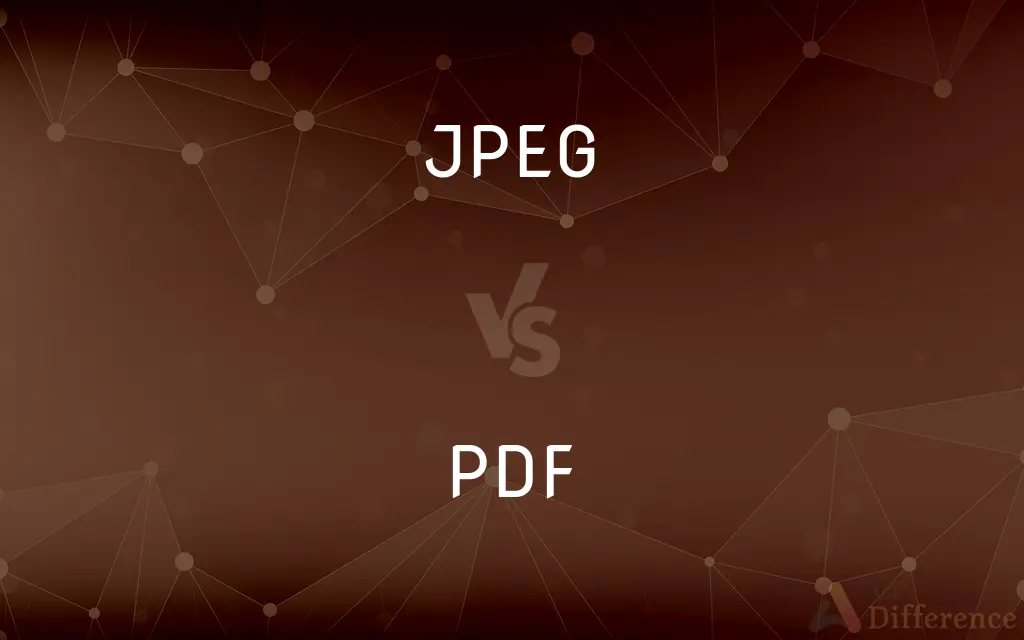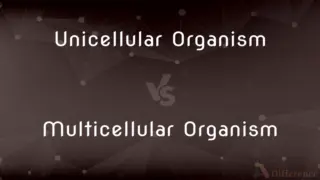JPEG vs. PDF — What's the Difference?
By Tayyaba Rehman — Published on January 22, 2024
JPEG is a compressed image format with lossy compression, ideal for photographs; PDF is a versatile document format preserving layout, text, and images, suitable for diverse content types.

Difference Between JPEG and PDF
Table of Contents
ADVERTISEMENT
Key Differences
JPEG (Joint Photographic Experts Group) is a widely used digital image format, primarily for photographs and web graphics, known for its efficient compression which reduces file size but can lead to quality loss. PDF (Portable Document Format), developed by Adobe, is a file format used to present documents independently of software, hardware, or operating system, preserving the original layout and content.
The main characteristic of JPEG is its lossy compression, which significantly reduces file sizes by simplifying details, making it ideal for sharing photos online. PDF files, in contrast, can contain a variety of content including text, images, and vector graphics, and maintain the quality and layout of these elements consistently across different viewing platforms.
JPEG files are best suited for photographic content and are commonly used in digital photography and online image sharing. PDFs are more versatile, often used for digital documents like ebooks, application forms, and printable content, able to embed fonts and multimedia elements.
While JPEG is primarily an image format, offering no support for text recognition or editing, PDF files are interactive, supporting embedded hyperlinks, form fields, and digital signatures. This makes PDFs ideal for official documents, forms, and information dissemination.
Editing a JPEG image can lead to further quality degradation due to its compression method. PDF files, however, can be edited with specialized software while maintaining the integrity of the original content, making them more suitable for official and professional documents.
ADVERTISEMENT
Comparison Chart
Format Type
Image format
Document format
Compression
Lossy, reduces file size
Preserves original quality
Primary Use
Photography, web graphics
Documents, ebooks, forms
Content Support
Primarily images
Text, images, vector graphics, multimedia
Editing and Quality
Quality loss with editing; best for photos
Editable with consistent quality; versatile content
Compare with Definitions
JPEG
JPEG is a popular image format with lossy compression.
I saved the photo as a JPEG to reduce its file size.
PDF is widely used for digital forms and ebooks.
I downloaded the manual as a PDF for easy reading.
JPEG
JPEG is favored for its balance of quality and size.
I chose JPEG for its good quality despite compression.
PDF supports embedded hyperlinks and multimedia.
The presentation PDF had embedded videos.
JPEG
JPEG is ideal for digital photography and online sharing.
Most of my website images are in JPEG format.
PDF files can contain text, images, and interactive elements.
I included fillable forms in the PDF document.
JPEG
JPEG format compresses images to manageable sizes.
I compressed the picture to a JPEG to save space.
PDF is a versatile document format preserving layout and content.
The report was distributed as a PDF to maintain formatting.
JPEG
JPEG files can suffer quality loss upon editing.
When I edited the JPEG image, it lost some clarity.
PDF maintains document integrity across platforms.
The PDF looked the same on my phone and computer.
JPEG
A standard algorithm for the compression of digital images.
JPEG
A digital image stored as a file so compressed
A JPEG of a cat.
JPEG
Alternative case form of JPEG
JPEG
A standardized format for storing graphic data in binary computer files, allowing over 16 million different colors. It allows for lossy compression, i. e. the compression of data into a form which re-expands into an image close, but not identical to the original image. Files stored in this format usually carry the extension jpg or jpeg. Compare GIF.
Common Curiosities
What is a JPEG?
A compressed image file format.
What does JPEG stand for?
Joint Photographic Experts Group.
Is JPEG good for high-quality printing?
It's acceptable but not ideal due to compression.
What is a PDF?
A format for presenting documents consistently.
Can JPEG images be edited?
Yes, but editing can reduce image quality.
Why is JPEG popular online?
Due to its small file size and decent quality.
Can PDFs contain images and text?
Yes, along with vector graphics and multimedia.
Can I edit a PDF?
Yes, with specific software.
Are PDFs good for document archiving?
Yes, they preserve layout and content integrity.
Can I convert a JPEG to a PDF?
Yes, JPEG images can be converted into PDFs.
Is PDF suitable for printing?
Yes, it maintains layout and quality.
Who created the PDF?
Adobe Systems.
Why use PDF for forms and ebooks?
For its versatility and consistency across devices.
Do JPEGs support animation?
No, JPEGs are static images.
Can PDFs be password protected?
Yes, for added security.
Share Your Discovery

Previous Comparison
Unicellular Organism vs. Multicellular Organism
Next Comparison
Muay Thai vs. MMAAuthor Spotlight
Written by
Tayyaba RehmanTayyaba Rehman is a distinguished writer, currently serving as a primary contributor to askdifference.com. As a researcher in semantics and etymology, Tayyaba's passion for the complexity of languages and their distinctions has found a perfect home on the platform. Tayyaba delves into the intricacies of language, distinguishing between commonly confused words and phrases, thereby providing clarity for readers worldwide.
















































